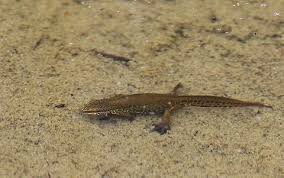The palmate newt (Lissotriton helveticus), also known as the common newt, is a species of newt found in Europe. It belongs to the family Salamandridae. Here are some key characteristics and information about the palmate newt:
- Size and Appearance:
- Adult palmate newts are relatively small, with males typically ranging from 6 to 9 cm in length and females from 8 to 11 cm.
- They have a smooth, olive-brown or yellow-brown skin with darker spots, and their underside is orange or yellow.
- Habitat:
- Palmate newts are found in a variety of habitats, including ponds, lakes, ditches, and slow-moving streams.
- They are known to inhabit both terrestrial and aquatic environments, spending much of their time in water during the breeding season and moving to land during other times.
- Breeding Behavior:
- Like many newt species, palmate newts undergo a distinctive breeding ritual. During the breeding season, males develop a webbed crest on their hind feet, which gives them their name.
- Mating takes place in water, and females lay eggs on submerged vegetation.
- Life Cycle:
- The life cycle of the palmate newt involves an aquatic larval stage followed by a terrestrial juvenile and adult stage.
- The larvae have external gills and develop into terrestrial juveniles before transforming into adults.
- Distribution:
- Palmate newts are found in various countries across Europe, including the United Kingdom, France, Spain, Germany, and others.
- Conservation Status:
- The conservation status of the palmate newt is generally considered to be of least concern. However, like many amphibians, they face threats such as habitat loss, pollution, and disease.
It’s worth noting that the palmate newt is just one of many species of newts, each with its own unique characteristics and habits. If you have specific questions or if you’re interested in a particular aspect of palmate newts, feel free to ask!
